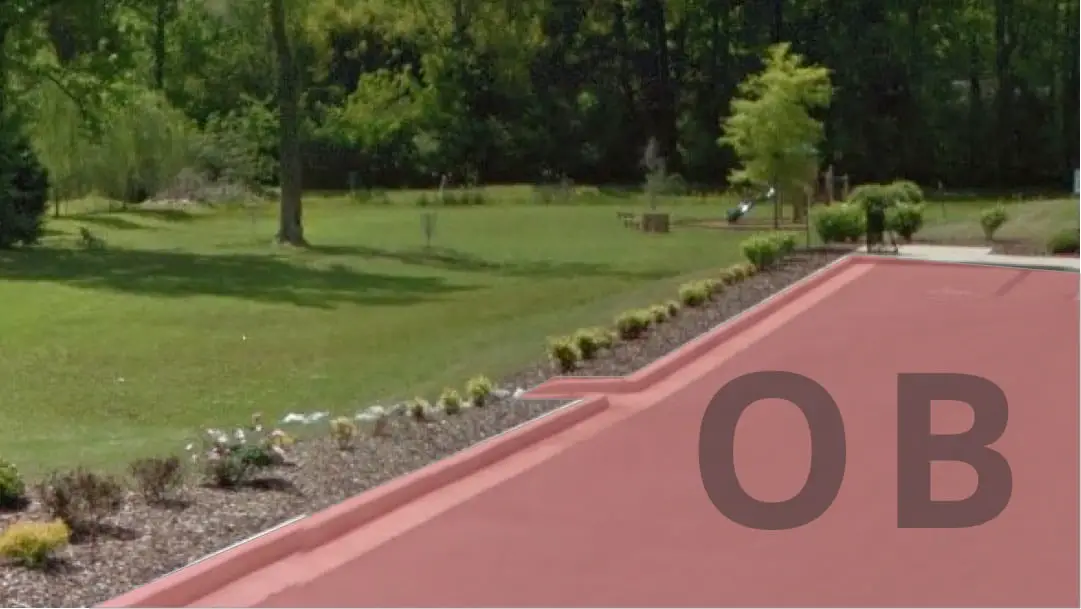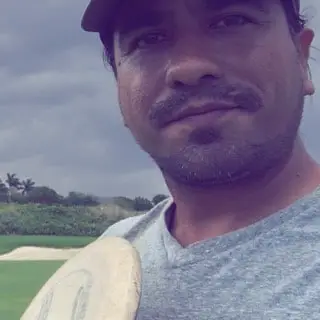An out of bounds in disc golf will add an extra stroke to your score on a particular hole. Out of bounds is the area outside the field used in a hole and course layout. Most out of bounds are marked with a perimeter like fencing, walkways, trees, water, and or ropes and signage in tournaments.
Let’s break down everything you need to know about playing and scoring for out of bounds so you’re prepared for your next big round.
What is out of bounds
Out of bounds (OB) is the area that lies outside of the playable area. This is marked by a line in tournaments or a perimeter on most courses such as a fence, body of water, pathway, street, etc. If a tournament has OB it should always be a visible mark with a line of some sort that makes it clearly defined.
When a disc lands out of bounds the player will receive one penalty stroke. The player then re-throws from the previous lie or brings the disc back to inbounds and throws their next shot. Exactly where the next throw comes from depends on a few factors. Let’s look at those.
Where to take your next throw after going out of bounds
You are not allowed to throw from out of bounds. You must set your next throw up in a way in which your stance is not out of bounds as well.
The disc landed on a road, path, or over a fence. You may re-throw from your previous lie or you and your card mates will determine where the disc was last in play. After that spot is agreed on the player would place their mini marker 1 meter (3ft) in from the boundary line or fence or whatever is the case. This will allow the player to take a stance and have room to throw without being out of bounds.
The disc goes out of bounds and there is a drop zone. A drop zone (DZ) is a tee-pad type area set up on a particular hole for a second drive after going OB. These drop zones are either made by the course designer or designated for tournaments. If you get an OB and the hole has a DZ go ahead and take your second drive from there.
the disc goes OB and is lost. A lost disc is still an out of bounds throw and you can treat it the same as the above options.
While playing a friendly round everyone should be helping each other look for discs when lost. This will not only speed things up as you’re beginning but will be the right thing to do since you’ll be needing the same help yourself soon.
In tournament play, the player will have three minutes to search for their disc. All players must be a part of the search.
What if I don’t know where out of bounds is
If your not sure where OB is on a particular course there’s some things you can use as guides.
- Most courses mark walkways as OB
- landing over a fence is OB
- bodies of water are OB
- Streets and parking lots are OB
- Lost discs are OB
Playing out of bounds on friendly rounds
When playing friendly rounds you don’t always have to count OB or add an extra stroke to your score. This can be a good method for beginners like yourself or if you’re teaching someone new.
OB’s can really add up when you’re new and can be damaging on ones spirit. Have fun! Don’t make everyone play by all the rules all the time.
Kids. Don’t make kids who are just trying to have fun play by OB rules. If you do I will find you. >:/ When they’re comfortable with the rule and ready to take on the extra strokes then it’s fine. Kids love to play competitively too.
If you’ve been playing long enough to have your drives, distance, and accuracy down a bit it’s good to add those strokes to your game. Think about all the factors like OB, wind, and possible routes. Make each throw count. Play safe if you have to.
This will prepare you for tournament play and put you into the mind set of every stroke counts.
If you’re looking for some great beginner drivers you may like to check out this post… Best Disc Golf Drivers Anyone Can Throw
The PDGA rules of out of bounds
806.02 Out-of-Bounds is the official OB rule set forth by the PDGA. If you’re playing in tournaments sanctioned or not by the PDGA I’d become familiar with these rules.
Tournaments not sanctioned by the PDGA may set their own rules for out of bounds and they should be clearly stated before each event.
Placing a mini marker 1 meter from the OB boundary line
If they choose, all players may take a “one meter relief” in from the OB boundary line. EVEN if this improves his or her lie.
You may not be standing in the OB area and so in some cases, you must take this meter relief. Take a body of water for instance. You’ll need that meter to give yourself adequate space to throw your next shot.
Always take a look at your possible obstacles and throwing routes before placing your marker. Taking that meter in can go a big way to avoid a fence or open up a new shot. Always check.
Once you’ve placed that mini and picked up your disc, your position has been set and may not be changed.
Add a penalty stroke to your score
If you’re playing by the rules or tournament always add yourself a penalty stroke. It’s embarrassing enough sometimes don’t make it worse by always making others call out your score.
It may be helpful to remind yourself what shot your taking. For instance, if I went OB on my first drive mark my spot then say to myself or out loud “I’m going for three.” Your first shot, a penalty, and this throw will make three strokes. If you need to make another throw remind yourself and others you’re “going for four” if needed.
Check out this article I wrote How To Keep Score Accurately In Disc Golf For Beginners if you need help keeping score.
Taking a provisional throw
In some instances, you may not be able to see the OB boundary line from where you’re driving. If everyone thinks it went out of bounds but it looks real close but the disc is hundreds of feet away it may be a good idea to take a provisional throw.
If there is a designated drop zone you would not need to take a provisional throw and would take your next drive from the dropzone.
Provisional throws are also used when the disc appears OB but the players in the groups can’t come to an agreement. The provisional throw would be taken and the player would then play out two different scenarios. Playing from OB and inbounds. Later the tournament director will assist in determining whether the disc was OB or not and which lay to use in the final score.
Conclusion
While playing out of bounds when you’re first beginning can be a big drag it can really help you improve your game. Most OB areas on a course are put there to add challenge to the game and the course. Challenge yourself and start marking those OB’s and improving your game.
If you’re just getting started you may find this article helpful: 10 First Steps To Playing Disc Golf For Beginners


